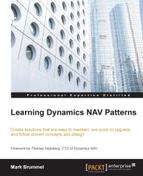Book Description
Create solutions that are easy to maintain, quick to upgrade, and follow proven concepts and designs
About This Book
- Design software that is maintainable outside the ecosystem of their creators
- Ensure quality by following patterns that have been proved to work
- Over two dozen practical Architectural and Design patterns
Who This Book Is For
Learning Dynamics NAV Patterns is intended for developers, architects, (technical) consultants, and application managers. You may have very little or no knowledge about NAV patterns, but you should be acquainted with programming.
What You Will Learn
- Apply object-oriented practices to C/AL programming
- Structure your application to avoid merge conflicts
- Refactor legacy code and avoid anti-patterns
- Design decision trees to decide when to use which patterns
- Clone codes and their application in Dynamics NAV
- Make your application extensible by creating predefined hooks and facades
In Detail
Microsoft Dynamics NAV is a complete ERP system, which also contains a robust set of development tools to support customization and enhancement. These include an object designer for each of the seven application object types, a business application oriented programming language with .NET interface capability, a compiler, a debugger, and programming testing language support.
Learning Dynamics NAV Patterns will guide you through the NAV way of solving problems. This book will first introduce you to patterns and the software architecture of the NAV and then help you to build an example application. Then, it walks you through the details of architectural patterns, design patterns, and implementation patterns. This book will also talk about anti-patterns and handling legacy code. Finally, it teaches you to build solutions using patterns.
Proven patterns and best practices will help you create better solutions that are easy to maintain in larger teams across several locations. It will guide you through combining abstract patterns using easy-to-understand examples and will help you decide which patterns to use in which scenarios.
Style and approach
This book explains the concepts of patterns, code structuring, and object-oriented concepts in a way that is easy to understand for Dynamics NAV specialists through practical examples.
Downloading the example code for this book. You can download the example code files for all Packt books you have purchased from your account at http://www.PacktPub.com. If you purchased this book elsewhere, you can visit http://www.PacktPub.com/support and register to have the code file.
Table of Contents
- Learning Dynamics NAV Patterns
- Table of Contents
- Learning Dynamics NAV Patterns
- Credits
- Foreword
- About the Author
- Acknowledgement
- About the Reviewers
- www.PacktPub.com
- Preface
- 1. Introducing Dynamics NAV Patterns and Software Architecture
- What do we mean by 'patterns'?
- Microsoft Dynamics NAV Design Patterns
- Patterns elements and hierarchy
- Building blocks
- Metadata
- Base application
- Summary
- 2. Architectural Patterns
- 3. Design Patterns
- 4. Building an Example Application Using Patterns
- 5. Coding Best Practices
- 6. Anti-patterns and Handling Legacy Code
- 7. Building Solutions Using Patterns
- Index
